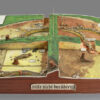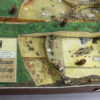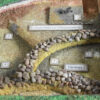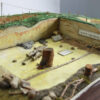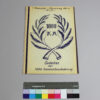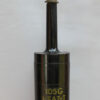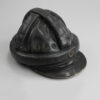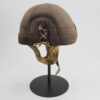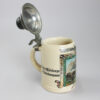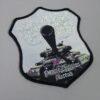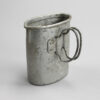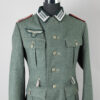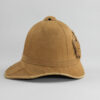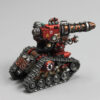Diorama of a burial mound on the Lehmberg, ca. 1965-1970
Inventory number: DPM 7.441
When the Wehrmacht established the Bergen military training area in 1935, the site also included numerous prehistoric monuments. They commissioned an archaeologist to map the “Siebensteinhäuser” group of stone tombs, 277 burial mounds and several ramparts between 1935 and 1944. After 1945, the Allies used the North German Plain for their maneuvers – not only military training areas but also fields and nature reserves.
In maneuvers, tank crews practiced finding a “partially covered position” for their vehicle – up to the hull, for example – and infantrymen were also supposed to “entrench” themselves, i.e. dig into the ground. However, the North German Plain offered little cover. The raised burial mounds were therefore often driven over with tank tracks or damaged by entrenching work, either through ignorance or negligence. At the beginning of the 1960s, the maneuvers could be better regulated and the cultural monuments on the training grounds began to be better protected.
The German Armed Forces supported the excavations of the civilian departments for the preservation of archaeological monuments by providing tents and water, as well as heavy equipment to move boulders, for example. In order to prevent further destruction, the burial mounds were marked with makeshift armored barriers and, in some cases, bilingual warning signs. This was so that both Bundeswehr soldiers on training exercises and British soldiers could recognize the cultural assets.
However, the work on the military training grounds was more dangerous than at other excavation sites. The soldiers in Bergen-Hohne did not practice with practice ammunition, but were able to fire with all of the army’s weapon systems. The danger from unexploded ordnance was correspondingly high. For reasons of secrecy, civilians were also only allowed on military grounds to a limited extent during the Cold War. The company commander of the Panzerjäger NCO training company of the Combat Training School III in Munster therefore founded a working group of archaeology enthusiasts. Since 1961, he has regularly carried out rescue excavations on military training areas in Lower Saxony and Schleswig-Holstein, as well as the “Red Areas” in the Lüneburg Heath, in consultation with the Lower Saxonian archaeological authorities.
In 1965, the working group of three to eight soldiers carried out a rescue excavation at the Bergen-Hohne NATO firing range for around six weeks. They were released from duty for this time or were allowed to take part in the excavations as a reward for good performance in accordance with the “Erlass Erzieherische Maßnahmen” (Educational Measures Decree). The barrow group near Lehmberg was already badly damaged in places. The diorama created as part of this work depicts one of the investigated burial mounds on a scale of 1:20. The head of the working group, Wilken Dürre, produced it both for documentation purposes and as an attempt to interpret the finds. Burial mound no. 1 is 19 meters in diameter, about 1.20 meters high and bordered by a wall. However, the burial ritual found appeared to differ greatly from other similar sites in the region from the older Lüneburg Bronze Age: The bodies had not been cremated, nor were there any traces of the typical tree coffin. In the case of one body, probably an older woman, the soldiers found grave goods made of bronze, such as a Lüneburg wheel pin, the remains of a bronze disk and a studded bracelet. The stone settings around the grave were intended to prevent the sandy heath soil from flowing apart. The finds were left on site and secured or handed over to museums and collections in consultation with the Lower Saxony Department for the Preservation of Monuments.
In addition to documenting the excavation in maps and publications, the working group also organized conferences and exhibitions. For a long time, one of the soldiers in the working group ran a private museum on prehistory and early history for the Bispingen local history and culture association with finds, dioramas and diagrams from the working group. Despite this commitment, the Bundeswehr decided against establishing a permanent position for a “military archaeologist”.
Object of the month
(short) stories from the depot
Unfortunately, many objects cannot currently be shown in the exhibition for conservation reasons. Here you will find unusual objects and exciting stories of special pieces from the depot


